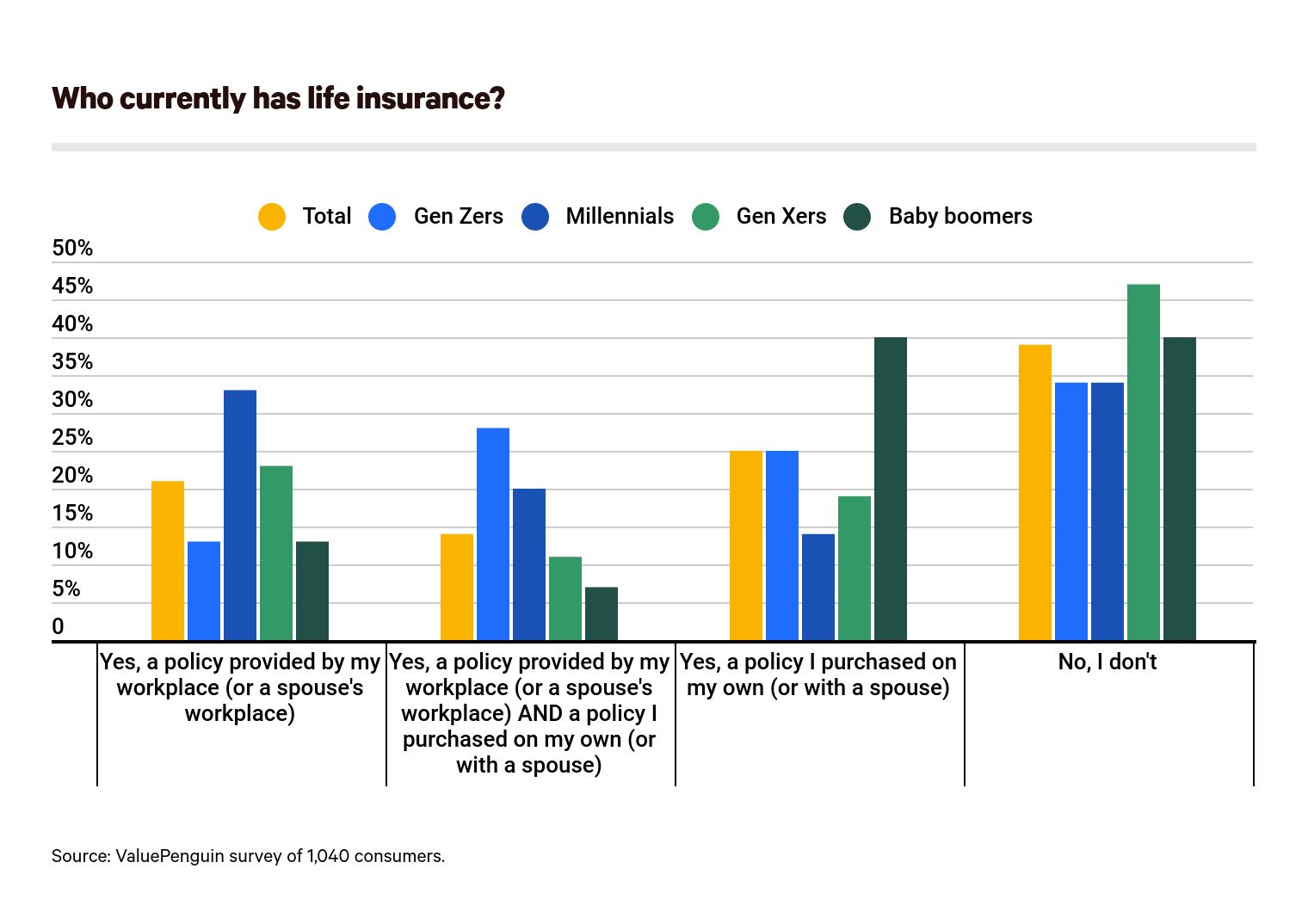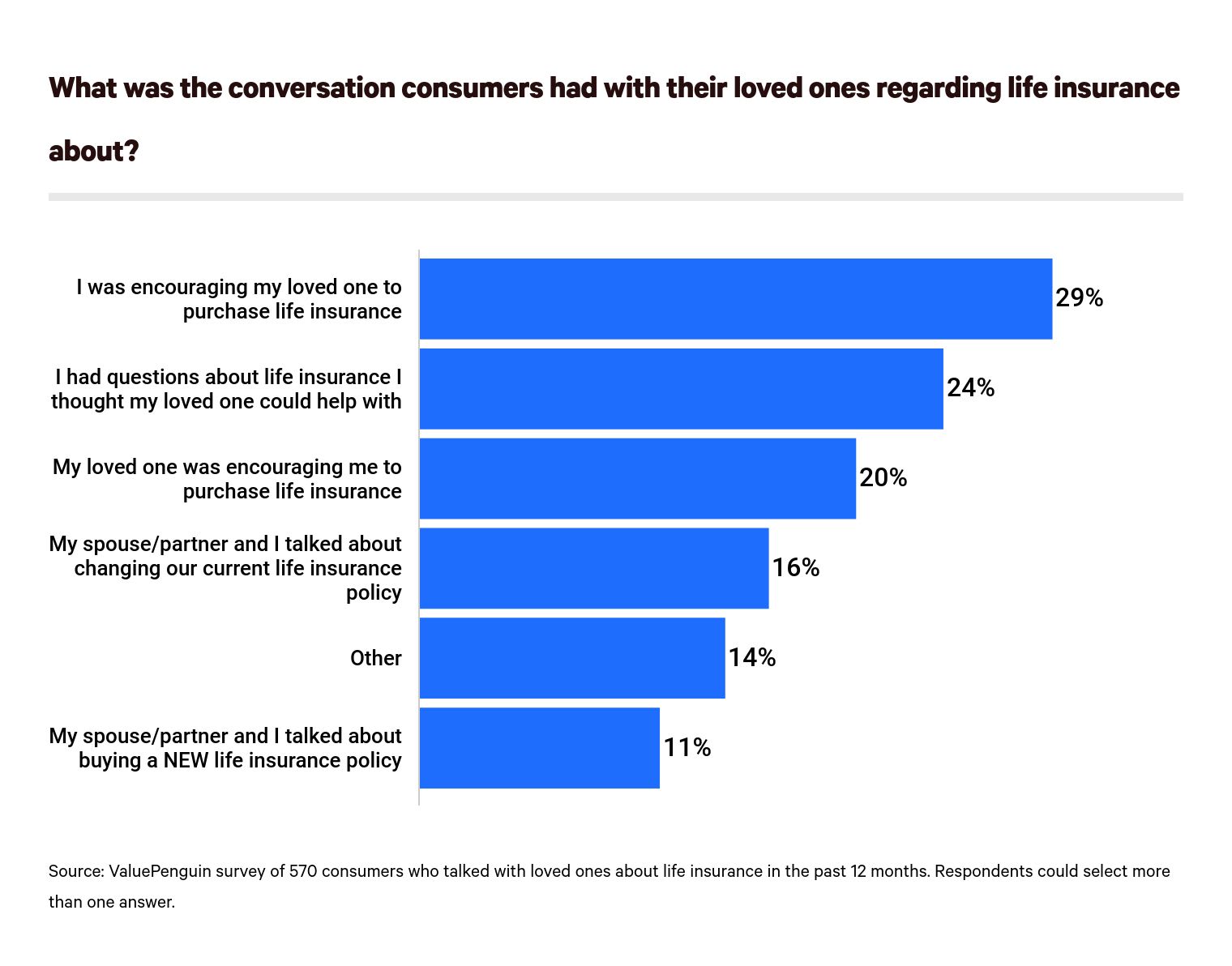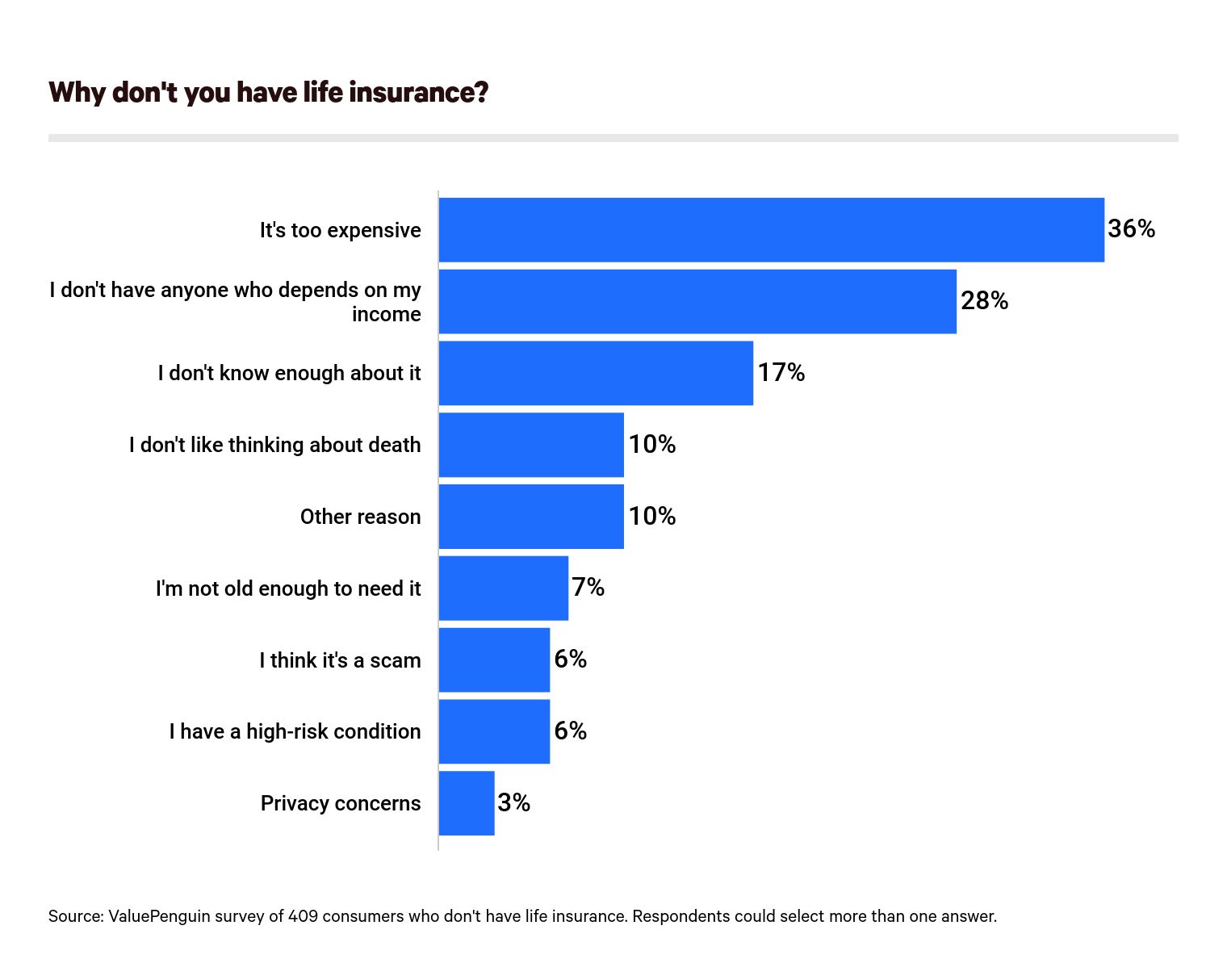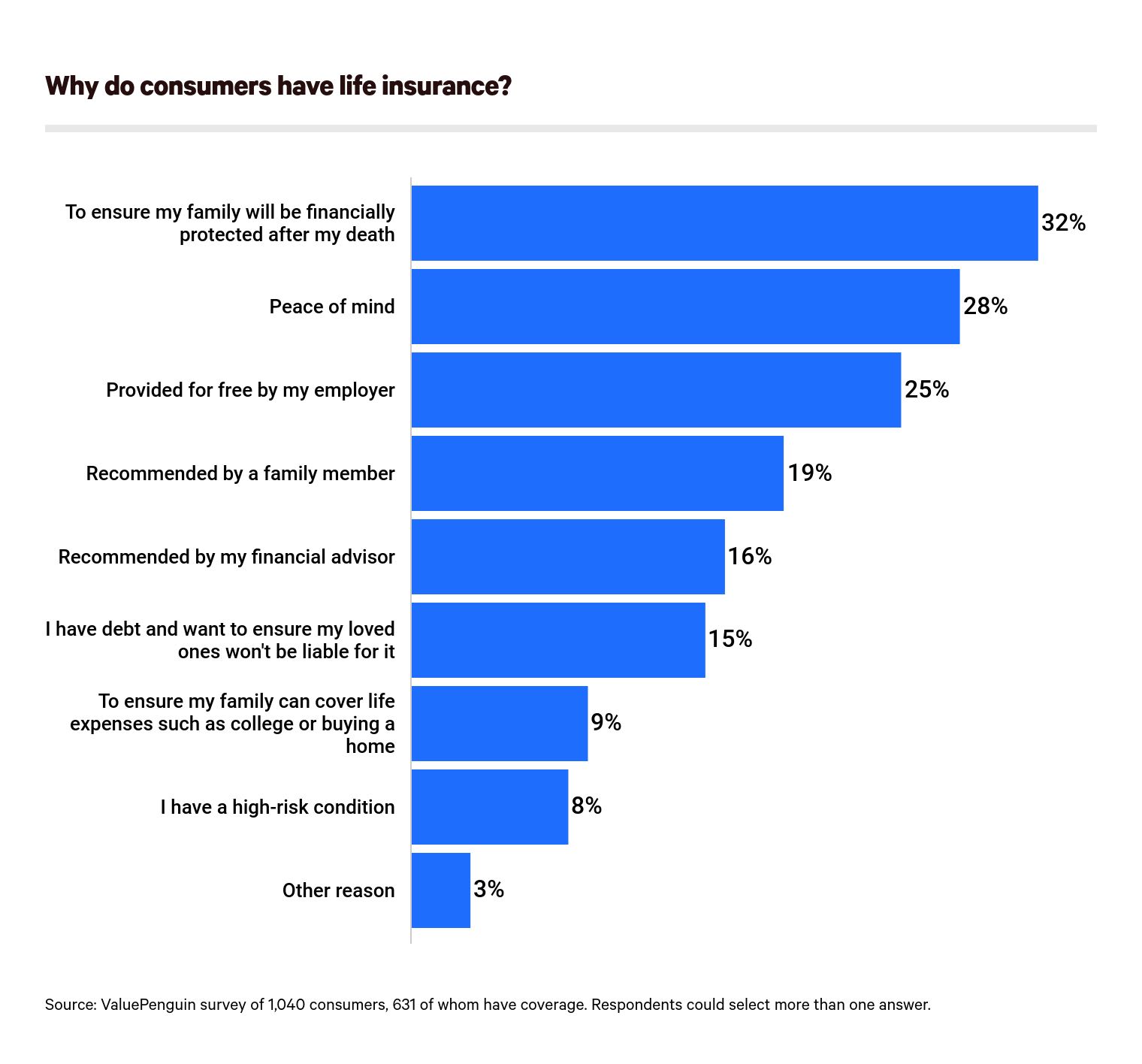Life Insurance
55% of Consumers Talked With Loved Ones About Life Insurance During Coronavirus Pandemic

Life insurance has inched toward the forefront of consumer consciousness over the course of the coronavirus pandemic. During the past year, more than half of consumers talked with a loved one about life insurance, according to the latest ValuePenguin survey of more than 1,000 Americans, and 13% were convinced to research life insurance options for the first time. Additionally, 1 in 10 purchased a life insurance policy for the first time, with younger consumers leading the way by a significant margin.
Although 23% said they view life insurance as a more valuable investment because of the pandemic, nearly 4 in 10 remain without coverage. And among consumers who do have coverage, they may not be carrying a sufficient amount. For example, 48% of those with employer-sponsored life insurance have no plans to supplement their coverage — and another 19% are unsure — even though these plans may not always carry enough protection for most people.
Despite the enthusiasm regarding life insurance that the pandemic has created among many first-time consumers, the benefits of life insurance are partially or wholly unclear for 55% of consumers. And while young people were most likely to talk with their loved ones in the past year about life insurance or purchase a policy for the first time, they were also less likely to see the upside of getting coverage than older Americans.
Key findings
- 55% of consumers have talked with a loved one about life insurance during the pandemic, and younger consumers (Gen Zers and millennials) were most likely to have these conversations.
- 13% of consumers researched life insurance options for the first time during the pandemic, and 10% purchased a life insurance policy for the first time. A whopping 24% of Gen Zers purchased their first life insurance policy during the pandemic, as did 17% of millennials.
- While the pandemic certainly generated conversations about life insurance, 39% of consumers remain without coverage, and those who have coverage may not have enough. For example, 48% of those who have employer-sponsored life insurance have no plans to supplement that policy, even though group coverage typically isn’t enough.
- A lack of comfort and confusion could be why nearly 30% of consumers would rather get a root canal than map out their insurance coverage needs. For example, 28% avoid thinking about life insurance because it’s too depressing, and — separately — just 46% said the benefits of life insurance are very clear.
- Consumers need more education about the different types of life insurance coverage available to them — and how that enhances their financial future. Fifty-five percent of respondents don’t clearly understand the difference between term life and whole life insurance, and many admitted they just don’t know enough about it to purchase a policy.

The pandemic has had vast impacts on Americans’ interest in life insurance, especially among young people
Twenty-three percent of consumers said they consider life insurance more valuable now than they did before the pandemic.
Fifty-five percent of consumers talked with their loved ones about life insurance during the pandemic — 24% of whom had more than one conversation. Young consumers were the most likely to have these conversations, with 72% of Gen Zers talking to friends or family about life insurance in the past year, compared with:
- 64% of millennials
- 50% of Gen Xers
- 44% of baby boomers
Young people, including Gen Zers and millennials, were also the most likely to have multiple conversations. Nearly 1 in 3 (31%) Gen Zers and 27% of millennials had repeated conversations on the subject, compared with 21% of Gen Xers and 20% of baby boomers.

The interest that young people expressed regarding life insurance appears to have carried over into the realm of action. Overall, 1 in 8 consumers of all ages researched life insurance options for the first time during the pandemic, with 10% purchasing coverage for the first time. For young people, however, these numbers were far higher.
Twenty-three percent of Gen Zers researched life insurance for the first time, and 24% purchased their first life policy during the pandemic. Similarly, 19% of millennials researched coverage for the first time, while 17% bought life insurance. These two groups were also the most likely to go over their existing coverage to ensure they had enough. Nineteen percent of Gen Zers and 20% of millennials attested to doing this — more than double older generations in both cases.
Response | Gen Zers | Millennials | Gen Xers | Baby boomers |
|---|---|---|---|---|
| Yes, researched life insurance types/options for the first time ever | 23% | 19% | 14% | 5% |
| Yes, reviewed the life insurance policy I currently have to ensure it's enough | 19% | 20% | 9% | 6% |
| Yes, purchased a life insurance policy for the first time | 24% | 17% | 5% | 2% |
| Yes, increased the amount of life insurance I already had | 9% | 6% | 4% | 2% |
| Yes, changed the type of life insurance I already had | 3% | 3% | 1% | 1% |
| No, none of these | 28% | 44% | 71% | 86% |
Source: ValuePenguin survey of 1,040 consumers. Respondents could select more than one answer.
29% of people, along with a large portion of the youngest consumers, would rather get a root canal than figure out their life insurance coverage needs — but why?
Despite the high percentages of young people who researched and purchased life insurance coverage during the pandemic, evidence shows that the youngest generations also carried negative preconceived notions about life insurance, or were less likely to get insurance because of the pandemic.
Thirteen percent of Americans countered that the pandemic has made life insurance a less valuable investment in their eyes, with 38% of Gen Zers agreeing.
On average, most people who don't have life insurance balked at the cost of life insurance coverage. Thirty-six percent think it's too expensive of an investment. However, uninsured Gen Xers (49%) and baby boomers (41%) were the most likely groups to have these opinions. Young people were more likely to avoid coverage because they believed they didn't need it, or voice suspicion about the very nature of life insurance.

Just 6% of all people who don't carry life insurance don't do so because they think it's a scam, but this number doubles for Gen Zers (12%). More commonly, Gen Zers and millennials don't carry coverage because nobody depends on their incomes (19% for both groups) or because they don't believe they're old enough to get it (16% for Gen Zers and 18% for millennials).
Moreover, Gen Zers and millennials were more likely to avoid thinking about life insurance because it can be a depressing subject. On average across all consumers, 28% of people felt this way regardless of their age. But across Gen Zers (37%) and millennials (41%), this refrain was the loudest.
But for both Gen Zers and millennials, one of the most common reasons why significant portions of their groups are uninsured is because they don't know enough about it.
Group | Very clear | Somewhat clear | Not clear |
|---|---|---|---|
| Gen Zers | 27% | 45% | 29% |
| Millennials | 35% | 42% | 23% |
| Gen Xers | 47% | 32% | 21% |
| Baby boomers | 61% | 23% | 16% |
Source: ValuePenguin survey of 1,040 consumers.
As consumers age, the survey found they’re more likely to have an understanding about the benefits of life insurance. On the other hand, the youngest generations more often had an incomplete or absent idea of those benefits compared to older groups. While 46% of Americans said they understood the benefits of life insurance, just 27% of Gen Zers and 35% of millennials were as confident. In fact, 73% of Gen Zers and 65% of millennials were at least somewhat — if not completely — unsure about what benefits life insurance carries.
How consumers can get the most out of a life insurance policy
While Americans feel unsure about, suspicious of or confused by the intricacies of life insurance, there are three ways that inexperienced consumers can better understand how much life insurance coverage they may need:
- Understand their needs and those of their families, if they have one
- Have an idea of how their lifestyle might shape what kind of policy they get
- Check to make sure more coverage doesn't become necessary without realizing it
Different consumers need different types of life insurance policies. The coverage people often carry — or don't — reflects this. For instance, 61% of Americans do have life insurance, but this number climbs by 10 percentage points for parents with kids younger than 18 and falls to 46% of those without kids. Likewise, ValuePenguin found that 79% of those with household incomes of $100,000 or more carried life insurance, while 64% of those making less than $35,000 were uninsured.
In both cases, data shows that those with different needs, expenses and living situations view life insurance as a useful or worthwhile expense. Consumers, especially those with low incomes or without families — who would depend on their incomes if they died — might naturally view the premiums that come with life insurance as an unnecessary or unrealistic expense, given their individual needs.
Those who do think that life insurance would be useful to them should next consider how much coverage their lifestyles require. For instance, the more income one earns or the size of one's family plays a part in the amount of coverage someone buys. Or, for others, some may be able to access cheaper or no-cost insurance plans with employer-sponsored plans after starting a new job.

As life continues, consumers should decide whether their policy's coverage reflects their own changing needs. We found that 55% of people weren't positive about the difference between term and whole life insurance policies, but both types appeal best to certain consumers.
Should you buy whole or term life insurance? Term life policies are generally best for consumers who want to protect their families from expenses in the next five, 10, 20 or 30 years. A parent who wants to make sure a child can afford college if they (the parent) died might opt for a term life policy. The power of a whole life policy as an investment tool makes it a better option for those who want more than small death benefits.
Alternatively, a policyholder who only has life insurance through their employer may need to supplement that policy eventually. We discovered that 48% of these Americans have no plans to supplement their employee-sponsored policies, but those who get married, for example, may find that their existing life insurance provides only inadequate spousal benefits and could consider a supplemental policy.
Methodology
ValuePenguin commissioned Qualtrics to conduct an online survey of 1,040 U.S. consumers from March 17-22. The survey was administered using a non-probability-based sample, and quotas were used to ensure the sample base represented the overall population. All responses were reviewed by researchers for quality control.
We defined generations as the following ages in 2021:
- Gen Zers: 18 to 24
- Millennials: 25 to 40
- Gen Xers: 41 to 55
- Baby boomers: 56 to 75
While the survey also included consumers from the silent generation (defined as those age 76 and older), the sample size was too small to include findings related to that group in the generational breakdowns.